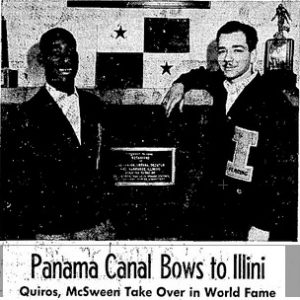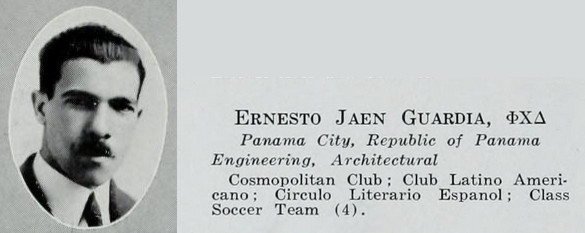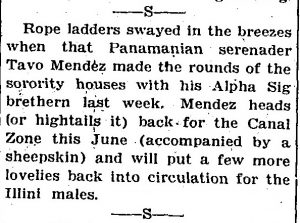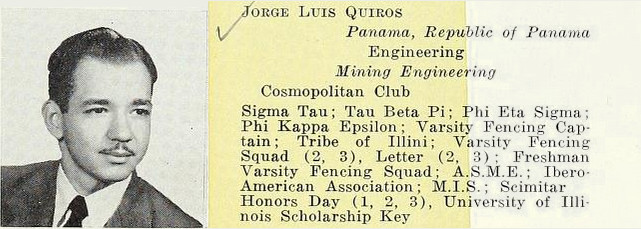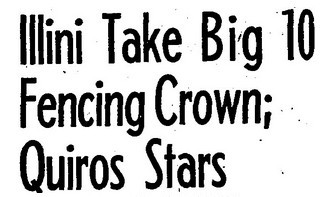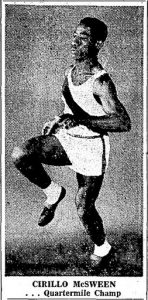Since at least 1914, Panamanian students have been coming to the University of Illinois. Panamanian Illini have included architects, architectural and mining engineers, business administrators, civil rights leaders, diplomats, fencers, Olympic athletes, politicians, a president, restaurant owners, serenaders, soccer players, sprinters, and transfer students. Read on to learn more about early Panamanian Illini!
- A Daily Illini interview with Mr. McSween (left) and Mr. Quiros (right), found in Record Series 41/8/801.
The Panama Canal
Since separating from Gran Colombia in 1903, Panamanian and Illinoisan connections have increased from great engineering projects like the development of the Panama Canal to the education of many future leaders in Panama. [1] Available in the University Archives, for example, from the 1880s to the completion of the Panama Canal and later events, a variety of University opinions and University guest speakers can be found in student publications like The Illini. In fact, many Illini would find employment in the development and administration of the Panama Canal. [2] Later, early Panamanian Illini included architects, architectural, civil, mechanical, and mining engineers.
Ernesto Jaén Guardia
Ernesto J. Guardia (B.S. Architectural Engineering, 1921) was both an athlete and a student leader in campus life. During his junior year, for academic year 1918-1919, Mr. Guardia joined the Latin American Club and Cosmopolitan Club. In Cosmopolitan Club, Mr. Guardia enjoyed the perks of being a member but in Club Latino Americano Mr. Guardia was elected sub-secretary in 1919. [3] As part of his service in Club Latino Americano, Mr. Guardia even gave talks on Panama and the Panama Canal. [4] He was also an athlete too. During his senior year, Mr. Guardia was the goalkeeper for the Senior Class soccer team. [5] During that same year, Mr. Guardia decided to extend his graduation date and he worked in Chicago during the Fall 1920 term, before finishing his degree in 1921. [6]
- Ernesto J. Guardia Illio Photo from the 1921 Illio, Page 72, found in Record Series 41/8/805.
Mr. Guardia’s senior year was eventful, as he even became the local expert on the Panamanian government’s foreign relations. As both a citizen of Panama and the nephew of the foreign minister of Panama, Mr. Guardia was a unique resource to the University community. In fact, he gave multiple interviews with The Daily Illini about a Panamanian-Costa Rican diplomatic disagreement over national boundaries. [7] As a DI reader, Mr. Guardia was an active editorial writer too, and he actively responded to DI editorials about Panama. [8]
- A Daily Illini interview quoting Mr. Guardia, February 27, 1921, page 1, found in Record Series 41/8/802.
- A Daily Illini interview quoting Mr. Guardia, March 12, 1921, page 1, found in Record Series 41/8/802.
- A Daily Illini editorial criticizing the Republic of Panama signed by L.M.W., March 24, 1921, found in Record Series 41/8/802.
- A Daily Illini editorial response to the L.M.W. editorial, signed by (future Ambassador and future President) Ernesto J. Guardia, found in Record Series 41/8/802.
After graduation, Mr. Guardia later returned to Panama where he had a career in architecture and politics. First, in 1926, with James C. Wright, he co-founded the architectural firm Wright, Haw & Jaén Guardia. [9] The firm developed many buildings in Panama. Later, Mr. Guardia entered public administration and he became Engineer of the Central Board of Roadways (Ingeniero de la Junta Central de Caminos), then Chief Engineer of the Department of Public Works (Ingeniero Jefe del Departamento de Obras Públicas), and at last he was Minister of Public Works (Ministro de Obras Públicas). Later, Mr. Guardia entered international politics when he became an ambassador and Second Vice President of Panama. In fact, during the 1941 transition of government from President Arnulfo Arias Madrid to President Ricardo Adolfo de la Guardia Arango, Mr. Guardia became President Guardia for three hours before his resignation. [10] During his brief time in office, President Guardia appointed a new Cabinet to elect a new president. Afterwards, Mr. Guardia served his nation abroad again as Ambassador to the United States from 1941 to 1943, before returning to Panama again.
Octavio Augusto Mendez Guardia
- Octavio A. Mendez Illio Photo from the 1940 Illio, Page 112, found in Record Series 41/8/805.
Octavio August “Tavo” Méndez Guardia (B.S. Architecture, 1940), was known as both a capable architect and a charming serenader during his last two years of undergraduate study. Before coming to Illinois, Mr. Méndez attended a Panama Canal Zone public school Balboa High School, then the Canal Zone Junior College. After graduation he began his studies at Purdue University in Indiana but he completed his studies at the University of Illinois. [11] Mr. Méndez had a campus-wide reputation for his serenades and his female friends. [12] In 1938, with graduate student Frank Morales, Mr. Méndez performed “Los Crillos” at Illini Union Women’s League Jubilee Show at the Lincoln Hall Theater. [13] That same semester, Mr. Méndez joined Alpha Sigma Phi, and with other Fine and Applied Arts students he was active in the decorations work of multiple campus dances. [14] Mr. Méndez was an event planner and an event participator known across campus, and the DI reported that Mr. Méndez had a date to the 1938 Junior Prom too. [15]
- A Campus Scout article referencing Mr. Mendez, October 10, 1939, page 4, found in Record Series 41/8/802.
- A Campus Scout article referencing Mr. Mendez, May 26, 1940, page 4, found in Record Series 41/8/802.
During Mr. Méndez architecture studies, his distinguished work on portico design was recognized with a Beaux Arts award First Mention and he later received a Ricker Prize in Architectural History. [16] [17] Mr. Méndez was also the son of Dr. Octavio Méndez Pereira who was an educator, essayist, novelist, former delegate to the League of Nations, ex-minister to France and England, and a cofounder of the University of Panama. [18] In 1940, for reasons unstated, Mr. Méndez’s famous father broadcasted a message to both of his sons. [19] After graduation, Mr. Méndez continued his studies, worked for the U.S. government, and then returned to work in Panama. Like Mr. Guardia, Mr. Méndez’s hard work during and after his studies helped him become another esteemed architect of Panama.
Jorge Luis Quiros
- Jorge L. Quiros Illio Photo from the 1951 Illio, Page 141, found in Record Series 41/8/805.
Jorge Luis Quiros (B.S. Mining Engineering, 1952, M.S. 1954, PhD 1966), sometimes known as the “Hottest-Foiler-at-Huff”, was both a student organization leader, a scholar, a great fencer. [20] In 1949, Mr. Quiros was elected Vice President of Cosmopolitan Club and later he would become Club President. [21] Always thinking of Panama and other cultures, throughout his studies, Mr. Quiros co-organized Panamanian and Latin American cultural events off-campus at the YMCA. [22] As a sports team captain, Mr. Quiros was once asked to be a high school beauty contest judge too. [23] Although he originally came for an undergraduate degree, Mr. Quiros and other Central American scholars of his generation benefited from a United States Agency for International Development (USAID) funding program for advanced studies. As a scholarship recipient, Dr. Quiros was able to complete all three of his degrees at the University of Illinois. [24]
- A Daily Illini interview with Mr. Quiros, found in Record Series 41/8/801.
- A Daily Illini interview with Mr. Quiros, found in Record Series 41/8/801.
Mr. Quiros studied fencing under Illinois coaching legend and author Maxwell Garret, and those years of award-winning fencing were never forgotten. [25] During Fall 1948, 150 students tried-out for the 1949 fencing team and 58 made the cut, including freshman Jorge Luis Quiros, foil, who was elected Captain of the freshmen. [26] That same year, Mr. Quiros joined the recently restarted honorary fencing fraternity “Scimitar” too. [27] By 1950, the always growing fencing team utilized a competitive “ladder system” for team members to challenge each other for top rankings on the team. As may be expected, Mr. Quiros was a leader for the foil but he would distinguish himself with another sword. [28] Early in 1950, Coach Garret switched Mr. Quiros to a sabre and the wins continued including an impressive 18-match winning streak. [29] In fact, during Mr. Quiros’s time as a fencer, the UI team had won three consecutive Big Ten titles. [30]
- A Daily Illini photograph of Mr. Quiros, found in Record Series 41/8/801.
- A Daily Illini Headline about Mr. Quiros, found in Record Series 41/8/801.
- A Daily Illini Headline about Mr. Quiros, found in Record Series 41/8/801.
- A Daily Illini Headline about Mr. Quiros, found in Record Series 41/8/801.
Cirilo Alejandro McSween
- Cirilo A. McSween Illio Photo from the 1953 Illio, Page 492, found in Record Series 41/8/805.
Cirilo A. McSween, (B.A. Liberal Arts and Sciences, 1953) came to the University of Illinois as an athlete, he left as a businessman, and he lived an influential career advocating human rights. [31] Mr. McSween’s speed and accomplishments in track and field took him from Panama to Wisconsin’s Marquette University and finally to Illinois. Over his four years on campus, Mr. McSween had a variety of nicknames from Daily Illini writers including, the “courageous Illini quarter-miler”, “Panama Clipper”, the “Panama Limited”, a “Panamanian flash”, and a “Panamanian goodwill ambassador”. What brought Mr. McSween to the University of Illinois was a recommendation by famous Illinois athlete Herb McKenley, during a conversation at the Central American and Caribbean Olympic games in 1947. [32] To stay in top physical condition, Mr. McSween and other athletes worked at local construction sites too. [33]
- A Daily Illini stock photo of Mr. McSween, found in Record Series 41/8/802.
- A Daily Illini article about Mr. McSween’s good sportsmanship, found in Record Series 41/8/802.
- A Daily Illini article about Mr. McSween’s sports career, found in Record Series 41/8/802.
As a student, Mr. McSween was involved in student life activities in organizations like Cosmopolitan Club and Ibero-American Club. Mr. McSween was also a dancer. For the Ibero-American Club and YMCA Supper Club, he performed mambo and rhumba arrangements. [34] For the 1952 Illinois Pep Rally, he presented an original dance called “Go, Illini, Go”. [35] In Cosmopolitan Club and other organizations, Mr. McSween and other students found opportunities to discuss their cultural experiences and cultural criticisms of life in the United States. In particular, the joint YMCA-Hillel event “Through Their Eyes” presented foreign perspectives on the United States of the 1950s and it produced a significant amount of criticism from different students, reported with quotations in The Daily Illini. [36]
After graduation, Mr. McSween went to New York Life Insurance where he convinced them to hire him as their first Black sales agent. During his career, he also owned a chain of 11 McDonald’s restaurants in Chicago (including the iconic State Street location with American Civil Rights leaders artwork on the walls). Mr. McSween was part of the Civil Rights Movement too. He was treasurer of Martin Luther King’s Southern Christian Leadership Conference. He worked in finance for Rainbow/PUSH. Mr. McSween was even treasurer for the successful Chicago mayoral campaign of Mr. Harold Washington too. In fact, Mr. McSween’s life and career is too long to include in one blog post; but, like his Panamanian Illini peers past and present, his story began in Panama, it continued to thrive in Illinois, and he gave much to the world. [37]
Are you a Panamanian Illini? Do you know someone who is? We’d like to hear from you! Please send us a message or leave a comment below. We want to include you and your story, as we celebrate the first 150 years of the University of Illinois.
Happy First 150 everyone!
References
[1] A detailed, student-written overview of the early history of the Panama Canal can be read in: “The Panama Canal”, The Illini, October 3, 1887, pages 9-11.
[2] The 1916 Alumni Record identifies at least twenty-one different Illini who found employment in the Panama Canal Zone during the years of construction.
[3] “Club Elects New Officers”, The Daily Illini, page 10.
[4] “Latin-American Program Tonight”, The Daily Illini, January 16, 1920, page 7.
[5] The DI writer considered both teams to be unprepared to play on that day. Please see: “Seniors Down ’21 1-0 in Soccer”, The Daily Illini, November 6, 1919, page 2. The Seniors beat the Juniors; however, the Seniors lost to the Sophomores. Please see: “Sophomores Beat Last Year Men by 1-0”, The Daily Illini, November 13, 1919, page 3.
[6] “Campus Brevities”, The Daily Illini, February 13, 1921, page 8.
[7] The national border disagreement had lasted for most of Mr. Guardia’s life and his DI interview quotes him observing this. Please see: “Costa Rica-Panama Breach Not Serious–Guardia”, The Daily Illini, February 27, 1921, page 1; “Guardia Explains Panama Attitude”, The Daily Illini, March 12, 1921, page 1. For copies of the official Panamanian, Costa Rican, and United States government responses on this diplomatic issue, please see copies available via HathiTrust, including this Argument from Panamanian President Belisario Porras. In fact, one-time University of Illinois law lecturer (1902) was Secretary to Chief Justice of the U.S. during the Panama-Costa Rica Boundary Arbitration. Please see: “William Cullen Dennis”, The Semi-Centennial Alumni Record of the University of Illinois, Alumni Record of 1918, page 862.
[8] Please see this DI editorial: “The Administration and Panama” by L.M.W., The Daily Illini, March 24, 1921, page 4. Then, please see Mr. Guardia’s response: “The Panama Attitude”, by E. Jaen Guardia, The Daily Illini, March 30, 1921, page 4.
[9] “Ernesto Jaén Guardia“, Architectura Panamena, page 264.
[10] “Panama President Ousted in Favor of Democracy”, The Daily Illini, October 10, 1941, page 1; “Panama Leader Pledges U.S. Support”, The Daily Illini, October 11, 1941, page 1; “Gardia Named Ambassador”, The Daily Illini, page 1.
[11] A significant amount of the Balboa High School archives can be found in the Panama Canal Museum Collection of the George A. Smathers Libraries at the University of Florida. The digital collection includes yearbooks like The Zonian, which features student photographs like Mr. Mendez in 1935 on page 30. Also see the 1936 The Conquistador yearbook of the Canal Zone Junior College, for more photographs of Mr. Mendez and his peers. For more career highlights, please see online memorials like MasArquitecturaMasArte’s “Homenaje al Arquitecto Octavio Mendez Guardia”.
[12] In multiple publications, he is described as a seranader. Please see: “Campus Scout”, The Daily Illini, October 10 1939, page 4;
[13] “17 Acts Feature Minstrel Show”, The Daily Illini, January 19, 1938, page 3.
[14] “76 Men Initiated by 11 Fraternities Over the Weekend”, The Daily Illini, March 1, 1938, page 2. In 1939, he was elected vice-president too. Please see: “Yourself and Others”, The Daily Illini, January 15, 1939, page 3. For
[15] His date was “Kathryn Bright”. “Houses List Upperclassmen Who Will Attend Prom”, The Daily Illini, December 16, 1938, page 1.
[16] “Students Receive Beaux Arts Awards”, The Daily Illini, February 17, 1938, page 2.
[17] “Honor Plym ’97 at Architects Banquet”, The Daily Illini, May 6, 1938, page 5.
[18] “Octavio Méndez Pereira”, Who’s Who in Latin America, 1945, page 95-96. For Dr. Méndez Pereira’s legacy at the University of Panama, please see: “Dr. Octavio Mendez Pereira“, Repositorio Institutional, Sala Digital de la Universidad de Panama.
[19] Mr. Mendez had a brother Manuel who was a law student at George Washington University. “Father will Broadcast Letter to Student” The Daily Illini, March 10, 1940, page 40.
[20] “Campus Scout” by Ed Hercer, April 3, 1951, The Daily Illini, page 4.
[21] “Party Line”, The Daily Illini, May 6, 1949, page 5.
[22] In 1951, there was a Latin Review performance. Please see: “Latin Review Set for Saturday”, The Daily Illini, November 1, 1951, page 7. There was a Panama Dinner too. Please see: “YM to Host Panama Dinner Sunday Night”, The Daily Illini, Marh 6, 1953, page 2.
[23] “Sweet Stuff for Sweet Sixteen”, The Daily Illini, March 14, 1952, page 1.
[24] In Dr. Quiros’s dissertation acknowledgement, there is more personal information. Please see: Quiros, Jorge Luis, Engineering And Economic Aspects Of The Aluminum Industry, And The Potential Development Of Aluminum Production In Panama, 1966.
[25] For the Maxwell Garret Papers, including awards, correspondence, newspaper clippings, photographs, programs, and scrapbooks, please see: Record Series 16/5/21. For a biography of Mr. Garret’s career, please see: “Illinois Coaching Legend Maxwell Garret Dies“, FightingIllini.com, April 10, 2013.
[26] “58 Fencers Drill for Position on Varsity” by Gene Piazza, The Daily Illini, December 8, 1948, page 5.
[27] The student registered organization cards and other administrative materials can be viewed in Record Series 41/2/41, Box 21.
[28] “Illinois Fencers Face Rebuilding Job” by Ken Gelms, The Daily Illini, November 10, 1949, page 5.
[29] “Wisconsin, Wayne Fence Illini Here” by Ed Smason, The Daily Illini, March 4, 1950, page 5.
[30] “Fencing Team Foils Michigan State for 3rd Consecutive Big Ten Title”, The Daily Illini, March 25, 1952, page 5.
[31] For a biography of Mr. McSween’s career, please see: “Illini Great Cirilo McSween Passes Away“, FightingIllini.com, December 4, 2008.
[32] “Kranz-berries”, by Dick Kranz, The Daily Illini, September 23, 1949, page 5.
[33] “Besch’s Bull-Pen” by Morry Beschloss, The Daily Illini, August 10, 1951, page 4.
[34] “YM Supper Club to Hold ‘Fiesta'”, The Daily Illini, December 1, 1950, page 2.
[35] “McSween Creates Original Dance to Present at Pep Rally Friday”, The Daily Illini, October 9, 1952, page 2.
[36] “Foreign Students Give Impressions of U.S. at YMCA-Hillel Seminar”, The Daily Illini, February 22, 1951, page 3.
[37] A few select memorial tributes include: “Cirilo McSween: An Extraordinary Life” by Hermeme Hartman, Huffington Post, December 27, 2008; “Chicago Loses a Black History Maker“, Chicago Defender, November 11, 2008; “Illini Great Cirilo McSween Passes Away“, FightingIllini.com, December 4, 2008. Multiple talks by Mr. McSween can be found online too, including a career retrospective and tribute for New York Life Insurance colleagues.

